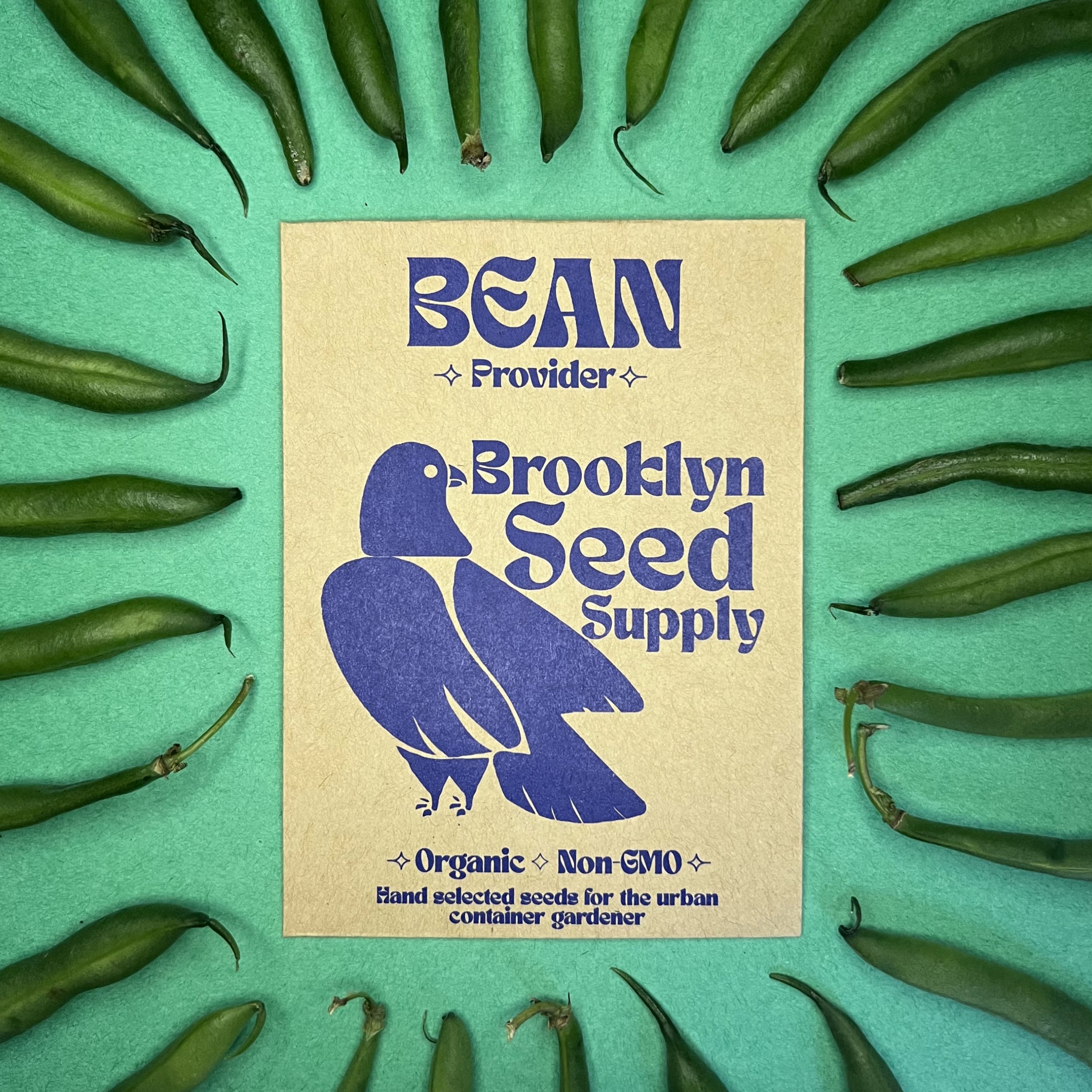Provider Green Been
When and how to start your seeds
Unlike many vegetables, beans do not need to be started indoors before being transplanted outside. Instead beans can be sown directly into the location where you plan to grow them.
After the final frost of the season, you can plant your beans once your soil reaches a suitable temperature. This variety is particularly hearty, but your soil should be 60°F (though warmer soil temperatures 70°F+ are even better); planting into soil that’s too cold results in poor germination rates. Average frost dates for your area can be found on the Old Farmer’s Almanac, among other sources.
Planting your seeds
Beans are one of the easiest plants to grow. If growing in a container, you should use one that is at least 15 inches deep and 15 inches wide. In general, the larger a container you use, the more your plant will thrive as its roots will have more room to grow and more nutrients to access due to the greater volume of soil. Wherever you plant you beans, make sure that it has plenty of drainage since waterlogged soil can end up drowning your plant.
To plant your beans, simply make a small hole roughly 1-2 inches deep for each seed, spacing each hole roughly 3 inches away from other holes. We recommend planting several seeds in each container to ensure that a plant develops. If multiple plants germinate, you should select the one that seems strongest and remove the others. Before sowing your seeds, you can apply a commercial inoculant which will help them take up extra nitrogen, however this certainly isn’t a necessary step and we’ve had excellent results without treating our seeds.
While not necessary, we recommended using a tomato cage or stake with this variety and installing it at the time you plant your seeds instead of later in the season to avoid disturbing roots and to give the plant a frame on which to train itself.
Caring for your newly planted seeds
Beans are incredibly simple to care for, simply keep the soil moist (but not water-logged) and they’ll be happy. Your seeds should germinate, in about 10-14 days, at which point you’ll have very tiny bean plants! If you’ve planted multiple seeds in one area, once plants reach about 6 inches in height, you’ll want to select the strongest looking seedling and remove the others.
Caring for your plants
Beans, like many vegetables, require lots of sun and nutrients. Plans should receive a minimum of six hours of direct sunlight a day. We’ve been able to produce fruit with less sunlight, but it’s been fare sparser, and smaller, than under sunnier conditions.
Keep your plants well watered, but not oversaturated. Your containers should have drainage holes or other features that allow excess water to escape. Keeping soil too wet will result in root rot and kill your plants. Containers, due to their limited volume, dry out quickly, so check your planters often; at the hottest part of the summer daily watering might be required. If you stick a finger one inch into the soil and it’s dry, your plants need to be watered.
If fertilizing your plants with a conventional product, a balanced or low-nitrogen fertilizer works best and can be applied monthly once your bean plants start to flower. Follow manufacturers instructions for all fertilizers but remember that under-fertilizing is better than over-fertilizing. A well-sourced compost applied monthly is another good options: add about half an inch over the top of the soil before watering. Remember that the finite nutrients in a container often need to be supplemented throughout the growing season for best results.
Your plants are open-pollinating, meaning that they are pollinated the traditional way that we think of plants being pollinated: bees visiting flowers, wind moving pollen, etc. While even in an urban environment we haven’t had much issue with pollination, if you'r plants seem to be dropping a lot of flowers (i.e. a flower appears, but no fruit is produced) you might want to consider manually pollinating them. To do so, take a soft-bristled paint brush and gently brush the inside of a flower; then brush the inside of another flower with the brush; continue moving around until all the open flowers on the plant have been brushed. A less labor-intensive way to encourage pollination is to gently shake the plant—this will cause the flowers to express their pollen and hopefully the pollen in the air will pollinate the flowers.
Harvesting and storage
This variety takes roughly 50-60 days to mature, meaning the time from planted into containers until they’re ready to harvest; weather conditions, care, nutrients, and other factors can extend this period. Once beans are 3 inches long, firm, and snappy you can begin harvesting, though we’ve found they have the best flavor around 5-6 inches in length. Don’t let your beans get too large or they’ll turn tough and stringy. Harvesting frequently will encourage your plant to produce more beans.
Use beans immediately or store them, unwashed, in the fridge in a plastic bag or airtight container where they should last for about a week. This variety is also suitable for canning.
Fast facts and technical jargon
Scientific name: Phaseolus vulgaris
Germination rate: 90%+
Life cycle: Annual
Days to maturity: ~50-60 days
Average size: 4-6 in.
Pollination type: Open pollination
Eco-consciousness: Organic, non-GMO
Starting window: Mar.-Jun.
Days to germination: 10-14
Adult heigh: 15-20 in.
Featured Product
Featured Product
Order your own organic, non-GMO Provider Green Bean seeds below

